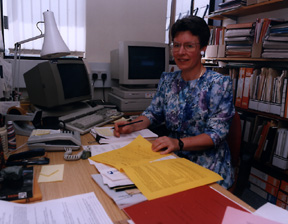 The woman who discovered pulsars:
The woman who discovered pulsars:
Jocelyn Bell
 The woman who discovered pulsars:
The woman who discovered pulsars: The woman who discovered pulsars:
The woman who discovered pulsars:
Jocelyn Bell was a graduate student mapping twinkling quasars under the direction of Tony Hewish in 1967 when she came upon unusually regular radio waves. The precision of the waves being so perfect, she thought that it must be interference of some sort, or perhaps extraterrestrial life signalling from a far off planet. At first, she jokingly labelled them LGM's (Little Green Men). Then a few months later she discovered another, LGM 2, and knew that, indeed, it couldn't be extraterrestrial life nor interference -- both were too unique in their identities. In February 1968 Hewish and Bell published an article in Nature magazine that discussed these findings. Jocelyn Bell, under the direction of Tony Hewish, had discovered the first pulsar.
From a recent Interview:
MKM: What is it like being a woman in the field of astrophysics?
BELL: In Britain we only have what you call the full professors; everyone else is what you would call a doctor. And of the full professors in Britain, which is about 150 of them, there are two of them that are women. The womenfolk of my generation definitely carried the load of child rearing and running the house as well. That means you're always working at full stretch. Working part time is a sensible thing when you have small children, but it means you have less time for research. I don't actually think the way promotions and recruitments are structured that sort of constraint is taken into account. Because the subject is predominately male, inevitably, the standards, the norms are the male. The system doesn't always stop to think, "Has this person had a career break, perchance, or there other constraints? Do we judge them by exactly the same rules as everybody else? In particular, do we use a quantity of achievement as a measure of ability which is awfully easy to do?" This person has a terrific publication record, that one doesn't; therefore, [publish or perish].
MKM: What is left for you in the field?
BELL: Maybe no single thing as big as the pulsars, but the fascination of the subject still remains. Astronomy is terrific. There is so much coming in. Keeping up with it all is difficult.
DGF: Where did you get the idea of maybe this is a neutron star, because neutron stars were purely theoretical?
BELL: And mad theoretical, at that point too. What was happening was initially a very small group of us were working on these curious signals -- Tony Hewish and I, and then gradually, as we devised more tests and things to do, more people got pulled in. For instance, we called in Paul Scott andhis student Collins who had a completely separate radio telescope that worked at the same frequency as ours. So we said, "Now, if their telescope can see that thing as well as ours, then it's not a figment of the imagination of our telescope. It's not that our telescope was malfunctioning, it was something curious. It's not a fault in the telescope or with the receiver. It is beyond that, it's two different telescopes with two different receivers." So we were gradually pulling in more people to help as we thought of more elaborate tests to do.
It became very clear that these objects had to be very compact, very small because they were pulsing quickly, rapidly. With hindsight we can also see they had to be very massive because they were very good time keepers. So they had big reserves of energy, they could blast out pulsar after pulsar after pulsar and there is no sign of them tiring.
So, gradually it came together, but to be honest I think it was finding the second one that was more like the classic discovery experience. Finding the first one was quite a bit of worry because it was so unexpected, it had to be man-made, there had to be something wrong with the equipment, it had to interference, it had to be satellites in the orbit. With so many things that we had to check out it was really quite a headache,[fearing] that we were spending all these hours checking out something and it would turn out to be utterly mundane and we would have literally wasted that time.
But finding the second one, that justified the point. I found the first four and the Crab Nebula was 6 or 8. The second one, fortunately, came along just about at the point where we were at a sort of impasse with the first one. We got so far and thought, "What do we do now? We have to publish this result very soon. We don't know how to handle it, we don't know what it is." That night we found the second one and, of course, we knew much better what that was. We'd been through all this before. So that was great, that was terrific.